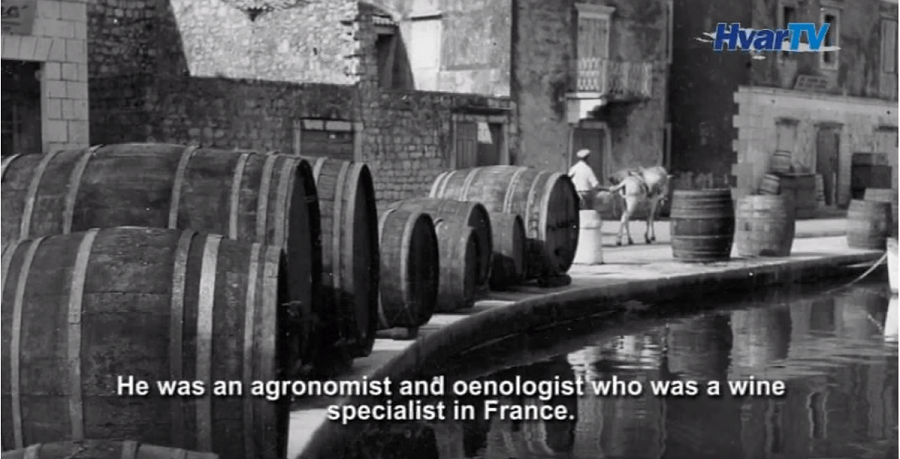Financial Times Discovers the Very Best of Croatian Wine
"This horseshoe-shaped nation doesn’t just produce good wines, but potentially great ones, and the wine world at large has yet to recognise this."
He is one of the great promoters of Croatian wine and its winemakers, and leading Croatian wine writer Sasa Spiranec has continued his work in spreading news about Croatian wine excellence through a recent collaboration with the Financial Times on a recent tour of the wine regions of Croatia, which the newspaper reported on on August 30, 2019. The article, entitles Croatia's Best Wines by Andrew Jefford can be read here.
The tour took in top wineries in Istria, Dalmatia, Slavonia and the Zagreb region, exposing Jefford to the full variety of the Croatian wine story. He allocated the most column inches for arguably Croatia's most interesting winemaker in recent years, Jo Ahearne MW on Hvar. The first Master of Wine to make wine in Croatia having moved to the sunshine island from London, Ahearne's use of indigenous Dalmatian grapes has attracted international acclaim, as well as customers as far away as Japan and Australia, but my favourite part of the article is the effect she is having on some much closer to her adopted home.
The Ahearne wines are outstanding and intricately crafted — yet true to their distinctive Croatian origins. “I was showing my wines at a festival in Split,” she recalled, “and a very glamorous woman came to taste. When she tasted my Wild Skins [a blend of Kuč, Bogdanuša and Pošip, made with skin contact], she had tears in her eyes. ‘I don’t understand,’ she said. ‘You are not Dalmatian; you’re not even Croatian — but when I taste this wine I remember all the aromas I smelled when I used to walk in the hillside with my grandfather when I was little.’ It was one of the nicest things anyone has ever said to me.”
To learn more about Croatian wine, check out the Total Croatia Wine introductory guide.
Festa Vina, 67 Years of Jelsa Wine Tradition on Hvar
August 31, 2019 - The biggest party in Jelsa awaits, as Festa Vina awaits in the Dalmatian wine capital. A look back at the fascinating history of this iconic Hvar wine festival.
Festa Vina in Jelsa (Jelsa Wine Festival) - a firm favourite of many along the Dalmatian coast, and a unique event whose history was only properly explained at a small but excellent open-air exhibition in picturesque St John's Square on Thursday night.
How to explain Festa Vina? A weekend of family fun, where food, wine and song meet family entertainment - from donkey races, climbing the pole to touch the prsut and even tug o'war. A case of Blackpool on the Adriatic was one description which comes close.
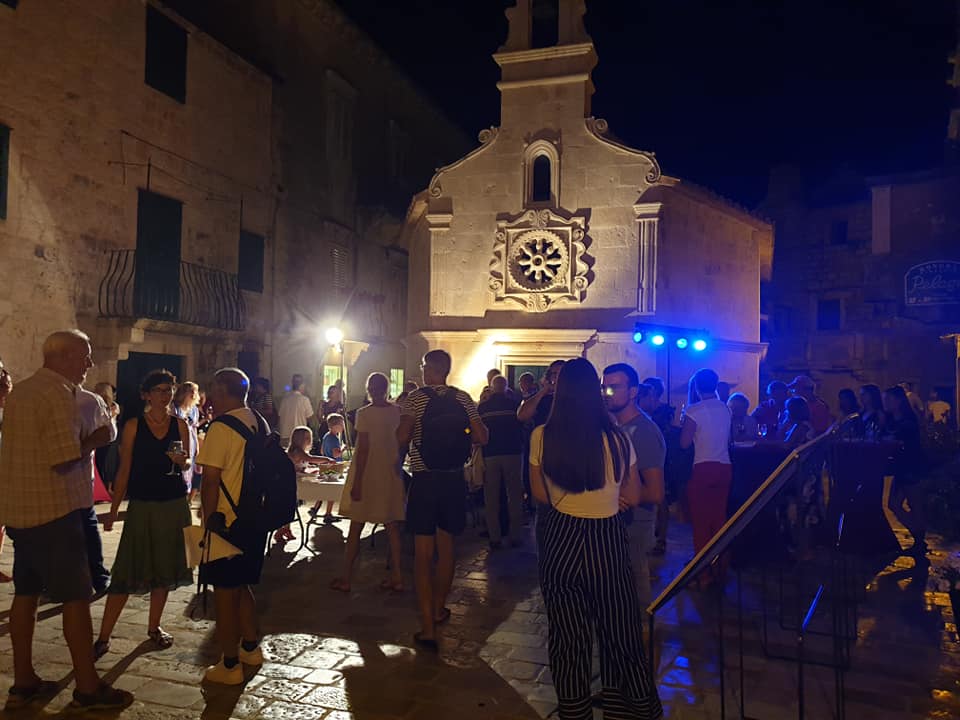
And yet for years Festa Vina has not really been associated with quality wine, which is somewhat ironic given that Jelsa has a proud wine tradition and today is home to a handful of the finest winemakers in Croatia. A chance to showcase the quality of the island's quality wines seemed somehow to get lost in the general party atmosphere, and for many years, the emphasis of the festival seemed to be more on beer and food brought from the mainland than local products and quality Hvar wine. So much so in fact, that the Hvar Wine Association decided no to attend Festa Vina a few years ago.
All that has changed in the last 3-4 years, with a much more concerted effort to return the focus to wine, and to celebrate the island's winemakers, who now occupy a prominent position on the waterfront with their wines available for tasting.
And to learn more about the origins of Festa Vina, the exhibition was full of surprises and great information. I should mention that some tourists complained to me that the exhibition was only in Croatian, which is true, although there is a very good English summary and timeline printout available - ask at the museum on Jelsa's prettiest square.
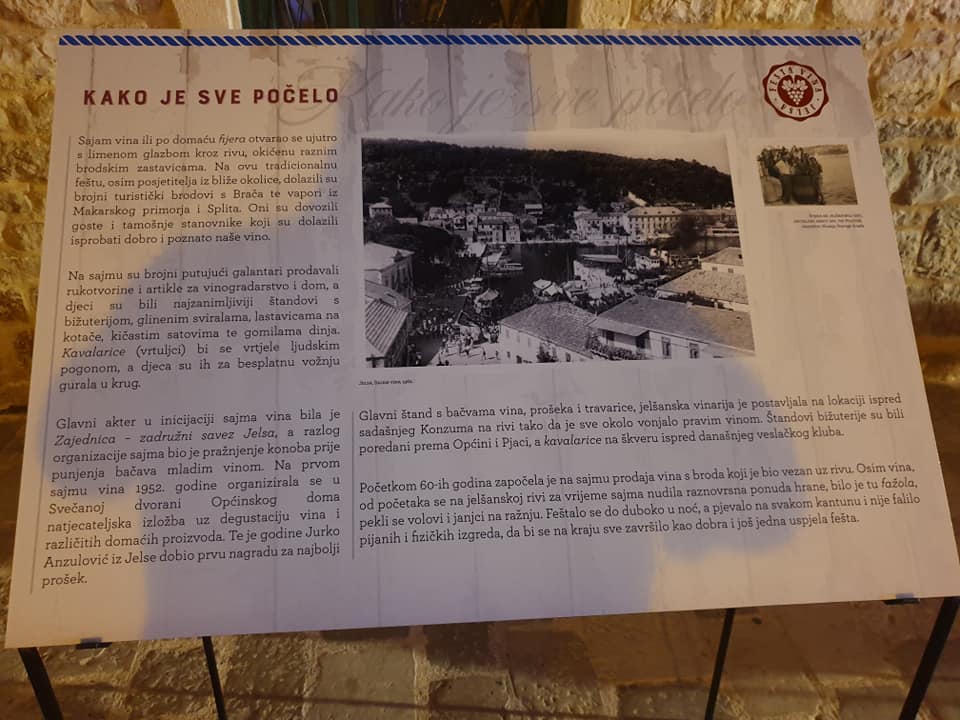
The first surprise was that the event dates back 67 years, all the way back to 1952. It was not a wine festival back then, but an agricultural fair, and it was conceived as a means to sell off all the old wines in the Jelsa cellars to make room for the new vintage. And it was certainly a huge success, with the statistics from 1957 reporting a staggering 60,000 litres of wine were sold, and "by the afternoon there was a shortage of cigarettes, bread, roasted meat, fruit and other supplies."
Initially known as The Regional Community Festival, the early events included brass bands from Jelsa, Stari Grad and Kastel Sucurac, water polo and football tournaments, theatre companies, national folk dancing, and a full-blown agricultural fair. People came in their boats and trucks to celebrate and buy wine to take home. Others were transported in steam boats from Split and the Makarska Riviera, and there was also organised transport from inland Dalmatia.
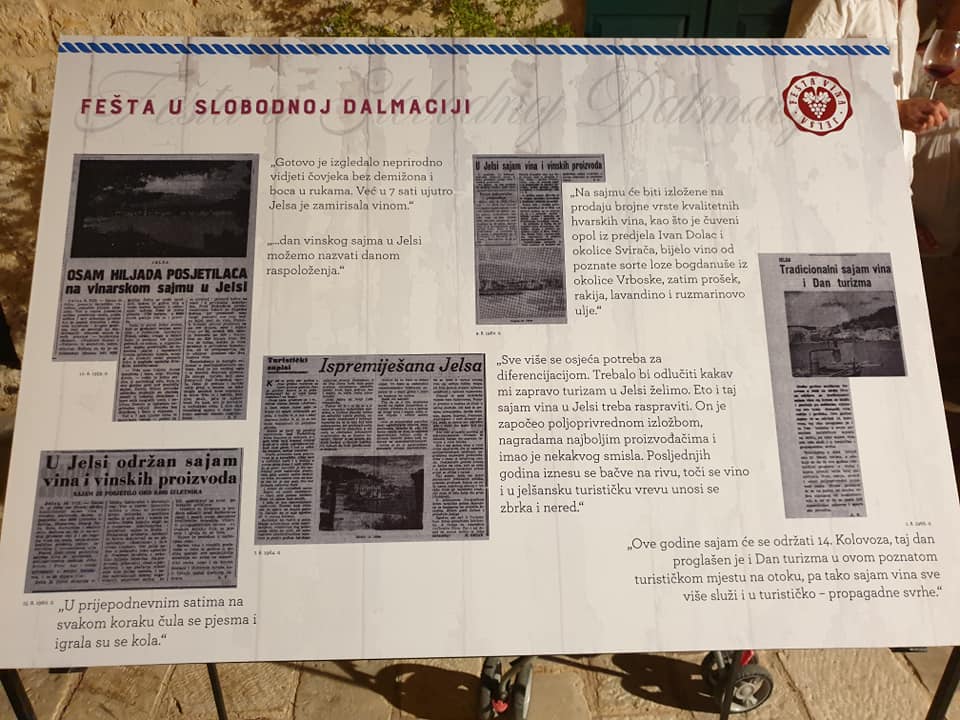
Business was certainly brisk, and the fair added to Jelsa's credentials as a top wine destination, but with so much alcohol flowing, it was inevitable that drunkenness occurred, which overflowed into violence (this in an era when the drunken British tourist had yet to be invented...), and despite the economic success, the fair was discontinued in 1969 or 1970.

And that might have been the end of the story until it was decided to resurrect the event in 1984, but with a different focus - a wine festival. The main organisers were the hotel company, Hvar wineries, the local community council, and Jelsa's restaurant and cafe owners. Festa Vina was timed to be the last weekend of August so as to prolong the season a little.
"Grilled sardines were an indispensable part of the menu offered by the restaurateurs. The wine company Dalmacijavino sponsored the wine barrels which were placed in front of the park. But it was not only the wine and food which attracted the many boatloads of people from Split, Omis, Makarska, Bol and other coastal towns. There were lots of different attractions happening in Jelsa during the Wine Festival. Aeroplanes towing banners used to advertise the festival, and parachutists would jump out of them. There were many games, competitions and sports, fireworks, flares on small boats - there was a buzz and enjoyment on every side."

A few weeks ago, I published an article on how Jelsa could easily improve its tourism without spending much money. A key element of that strategy is developing a brand for the destination, which it currently does not have. As the most important wine town in Dalmatia, a slogan like Relaxed Family Lifestyle in the Dalmatian Wine Capital immediately gives Jelsa a focus and a personality. Events such as Festa Vina give content and history to that brand.
It is 77 years since it started, and Festa Vina has undergone several changes in that time. The current trend - to focus more on the quality wine aspect - is the best approach in my opinion. The big party is tonight - see the programme below.
See you there?
If you are looking to learn more about the Dalmatian wine capital, check out 25 things to know about Jelsa.
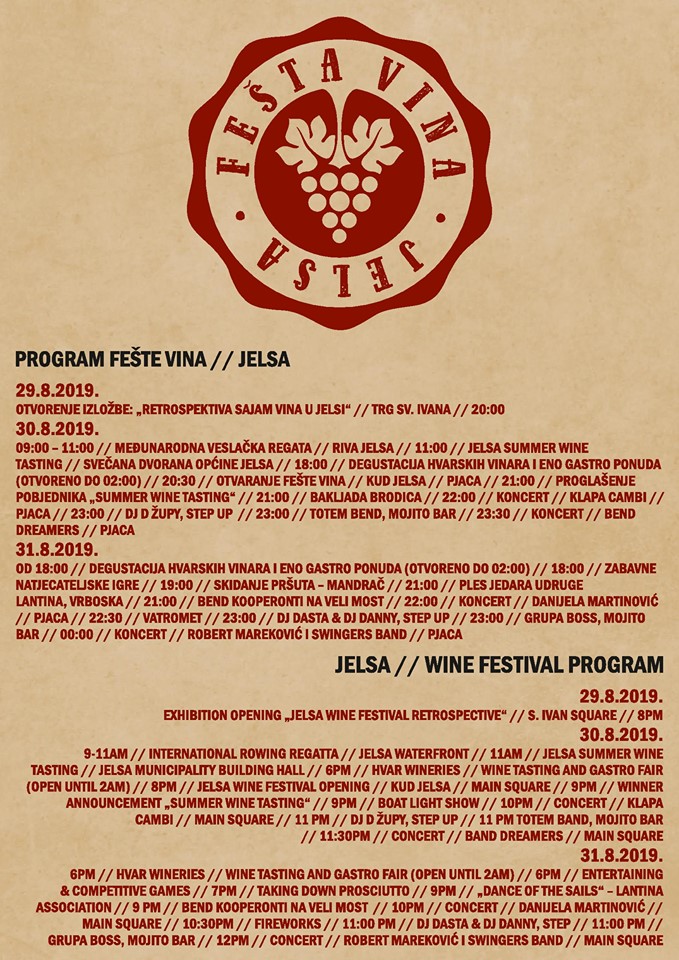
Dalmacijavino Winery Returned to Stari Grad: Home for Hvar UNESCO Gourmet Goodness?
August 10, 2019 - A new chapter for the troubled Dalmacijavino winery in Stari Grad, and a fantastic opportunity to develop the Hvar gourmet story.
When it opened in 1952, it was the most modern and beautiful winery in Croatia. Oenologist, agronomist and engineer Vanja Zanko returned from Provence in 1948 and started to build a new winery in Stari Grad, which was finally completed in 1952.
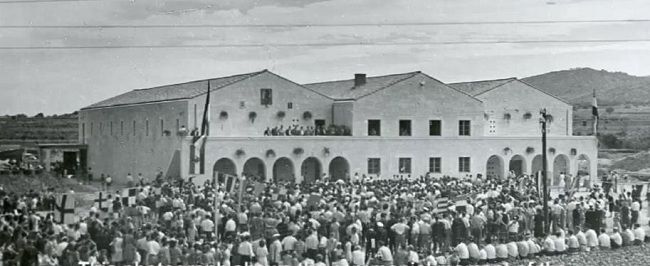
(The opening of the winery in 1952)
After initial glory years, the Dalmacijavino winery fell upon hard times, and it has been sitting unwanted and unused on the entrance to Stari Grad for many years now.
But no longer!
A unanimous decision from the Stari Grad Town Council this week has ensured a brighter future for the building and its surrounding lands, as the town will purchase them and bring the Damacijavino winery and surrounding lands into the ownership of the local authority, which is great news.
Significant investment will be required to restore the winery to its former glory, and while I am not aware of the plans for developing the winery, I would be surprised if it was returned to its original use as a winery. And perhaps there is a much better use for it.
As I wrote recently, Hvar is blessed with so many interesting, high-quality and unique food and wine experiences, that it can quite easily rebrand and expand its image as a food and wine destination immersed in culture (you can read Creating Quality Gourmet Tourism in Croatia: Case Study Hvar here).
(Hvar TV reports on a 2012 exhibition to mark 60 years of the opening of the winery)
Jelsa is the de facto (although unclaimed) capital of Dalmatian wine, Hvar the wine island, whose Mediterranean Diet joined the list of intangible UNESCO heritage in 2013, along with Brac and 7 other places on the Mediterranean. The winery is located on the edge of UNESCO World Heritage Site, the Stari Grad Plain. The location really could not be better.
So why not build a temple of celebration of Hvar's incredible wine story, its Mediterranean Diet, a proper introduction to the UNESCO World Heritage Site of the Stari Grad Plain, and a celebration of the rest of the UNESCO heritage on Hvar, the island with the most UNESCO heritage in the world?
A wine museum, a wine tasting facility, an interactive Stari Grad Plain exhibition, cooking classes and workshops. Plant lavender and immortelle and other Hvar crops in some of the neighbouring fields to showcase the diversity of Hvar's herbal and plant life which contribute to so many products here.
There is plenty of space for a multi-functional facility, including winemaking, under the brand of Hvar gourmet. Olive oil production, honey production, lavender oil production, rakija production - a section to learn how all these processes were done all those years ago, and still today. There will also be EU funding for the right application.
In an age where tourists are looking for things to do on a rainy day, could there be a better option? And not just when it is raining. The creation of a UNESCO Hvar gourmet centre would help to develop the brand, which could be further developed by the numerous food and wine tours on the island.
A fantastic opportunity. Let's see what happens, but whatever happens, the fact that there will be a change of ownership is great news. It comes around the same time that that the Helios Hotel Group, the main hotel provider in the town, is also looking forward to a brighter future, as Valamar looks set to invest to bring them up to four-star standard.
The future of tourism in Stari Grad is looking very bright indeed.
Learn more about Stari Grad with 25 things to know.
Why Jelsa's Tourism Future is Bright: Explained in 1 Tourist Facebook Post
August 3, 2019 - While Jelsa may be having a poor season with its current 2-star tourism strategy, the future is very bright indeed - listen to what the tourists are saying after they discover the secrets Jelsa doesn't share.
I have spent a bit of time this summer looking at the current state of tourism in my beloved Jelsa on Hvar. Saddened by the poor quality in a destination which could do so much better, I decided to give something back to the town which has given me so much - a proper tourism strategy, much of which can be implemented in time for next season. You can read Some Simple Steps to Improve Jelsa's 2-Star Tourism Strategy on Hvar, as well as a Croatian version here.

One of the key failures of Jelsa currently, after 108 years of tourism, is that nobody knows what Jelsa's brand is. There is something vague about it being a relaxing place, family-friendly, good wines. Nothing more. One local probably summed the general feeling better than most:
Jelsa today is not "branded". Now regarding the type of destination, I'd say it's a reasonably pleasant, family-friendly town
It doesn't exactly get you booking your flight, does it?
My suggestion (and you can read more in the link above) is to brand Jelsa as the Relaxed Family Lifestyle in the Dalmatian Wine Capital.
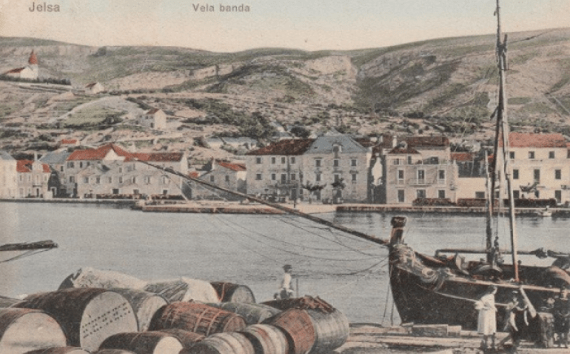
I want to tell you about one guest who rented our place recently. After arriving in Jelsa (and possibly through the information we made available, but not necessarily), he heard that there was a British Master of Wine somewhere near Jelsa, the only one in all Croatia.
With no car, the couple went off in search of the winery of Jo Ahearne MW, but ended up in the wrong village, in Pitve, before finally tracking down the winery in Vrisnik. They were disappointed to find it closed (Jo does tastings by appointment generally, as she is a one-woman band and there is plenty to do elsewhere). I am not in Jelsa at the moment, and when I spoke to my wife that evening, she mentioned that the guests were very keen to taste her Rosina rose in particular. Jo is a good friend of mine and I knew that she was playing with her Posip grapes on Korcula. I messaged her to find out when she was back, and it turned out there was a window before the guests left the island where she could accommodate them. As they had no car, my wife happily drove them to Vrisnik. As for the rest, I leave it to the Facebook comment on Jo's winery's Facebook page:
We did not know anything about the Dalmatian wine scene before coming to Hvar, and was prepared to drink beer and water as we have done on previous occasions. To our great surprise the island of Hvar has an immigrated master of wine in Jo Ahearne (you will only find around 400 masters of wine in the world, it is not like any other college degree), living only ten minutes drive from where we stayed in the beautiful city of Jelsa. We booked a tasting of her bottled wines (two whites, one rose and two reds), and was blown away by the quality of her winemaking. She uses mostly local grape varieties (Posip, Drnekusha and Plavac Mali). This is a totally different ballgame than other wines we have tried in Croatia, and absolutely worth a trip if you are into wine. Drenkusha is for example an indigenous grape found on the island, almost extinct, and in Jo´s hands turned into top-notch rose (which also landed a 90 point rating in the English wine magazine Decanter this July). Thank you for a great visit, we look forward to drink all the bottles that we brought home.
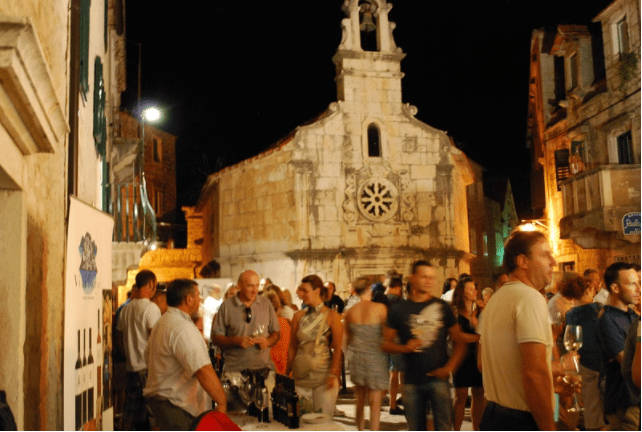
Fantastic, a win all round. Very happy guests, a successful tasting and some money in the pocket of a local business. Bottles purchased to take home and sample, perhaps with friends who could then learn more about Dalmatian wine and its capital.
But the post got me thinking. Everything about the story was 'slucajno' - accidental. The guest happened to hear about the Dalmatian wine scene, then about Jo. The tasting was finally arranged late at night (after 10pm) because the host happened to be a friend of the Master of Wine.
What IF the guests had known about the Dalmatian wine capital before arriving? While Jo is the undoubted star of the Hvar wine scene, there are many other winemakers in and around Jelsa who provide diverse and fascinating wine tasting options. I went into this at some length recently with my concept to brand Hvar as a gourmet destination - The Dalmatian Wine Capital with the UNESCO Mediterranean Diet.

What if instead of Jelsa today is not "branded". Now regarding the type of destination, I'd say it's a reasonably pleasant, family-friendly town, we changed it to the Relaxed Family Lifestyle in the Dalmatian Wine Capital.
"Hey honey, take a look at this place, it looks perfect. It is the capital of Dalmatian wine, with some great tasting experiences. The island's Mediterranean Diet is UNESCO-protected, so I bet the food is healthy and good. This Jelsa place apparently has great beaches, has a chilled lifestyle, great day trips, is very safe, laid back and family-friendly with a great little square for morning coffee and croissants. So lots to do with the kids, and all those indigenous grapes look really exciting to explore. Heck, they even have a British Master of Wine doing tastings of her wines made from indigenous Hvar grapes. What do you say, shall I see if I can find some nice accommodation with a terrace and sea view? It looks gorgeous."
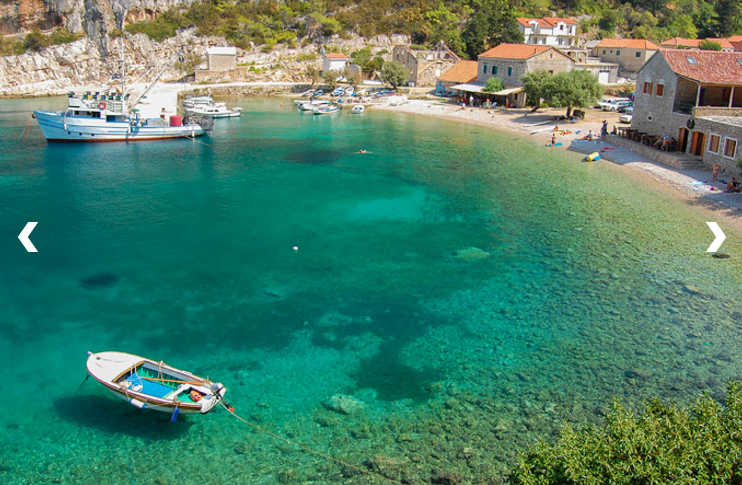
Learn more about the Jo Ahearne MW tasting experience just a couple of kilometres outside Jelsa.
Interested to learn more about Jelsa? 25 things to know about Hvar's (and Dalmatia's) wine capital.
Carpe Diem Swaps The Yacht Week for Hvar Wine Tasting Afternoons
July 30, 2019 - As Hvar moves its tourism story away from the party, is a new service from Carpe Diem the biggest symbol of change in the new direction? Meet Taste Croatia, Carpe Diem style.
A few months ago, I met and interviewed Petar Razovic, the new Hvar Town Tourist Board director, who had been in the position just over a year. I had assumed it would be just another standard interview listening to the same old stories, but there was something different about Razovic and his vision for Hvar. You can read the interview here.
He seemed determined to reset Hvar's tourism strategy away from the cheapening party destination it had become and more towards the elite destination it had been until fairly recently. With party boats jumping on the bandwagon of the infamous Yacht Week, it was sad to see the change that was occurring. Symbolic of that for many were the after beach parties at Carpe Diem, where up to 500 drunk 'sailors' would cram in for a party from 17:00 to 20:00, before being sent out to 'explore' the town, before heading out to Carpe Diem Beach at midnight to party until dawn.

Razovic, the town authorities and Carpe Diem have been in discussions as to how better manage the situation, so that the party can exist side by side with the rest of Hvar tourism, as it had done before. The Yacht Week was moved to the Pakleni Islands and reduced to just five times a month, and security guards would oversee the orderly departure to Carpe Diem Beach at Stipanska by night, and an orderly arrival early in the morning. When I stayed in late June (admittedly not the peak season), the system was working well, as you can see from my experience of a night in Hvar Town: Hvar Town, a Changing Destination: A View from Hotel Adriana Terraces.
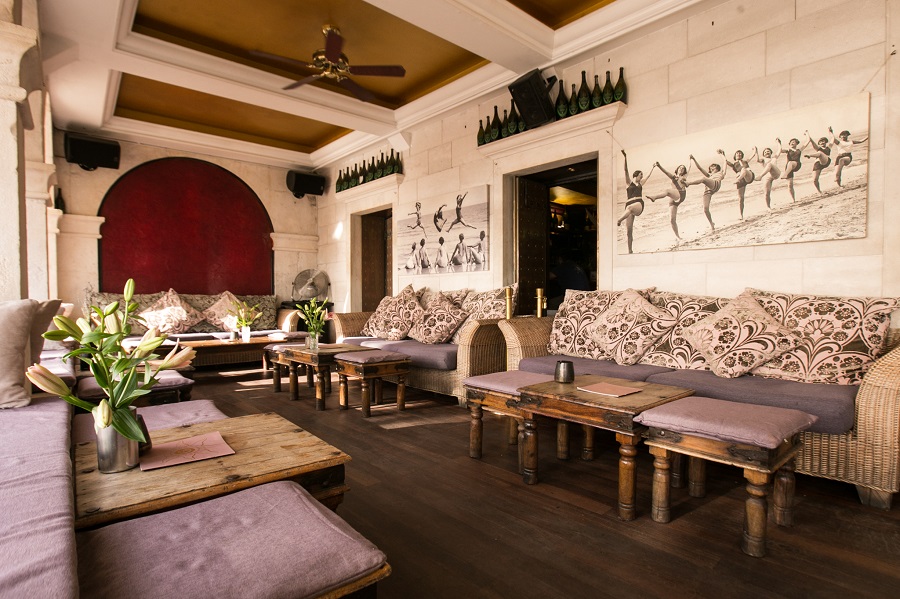
The oldest public theatre in Europe reopened after 20 years, the first luxury 5-star hotel on the island is due to open in a few weeks, it seemed that Hvar was really taking concrete steps to change. Rome was not built in a day, but the wheels were certainly in motion.
And then THIS!
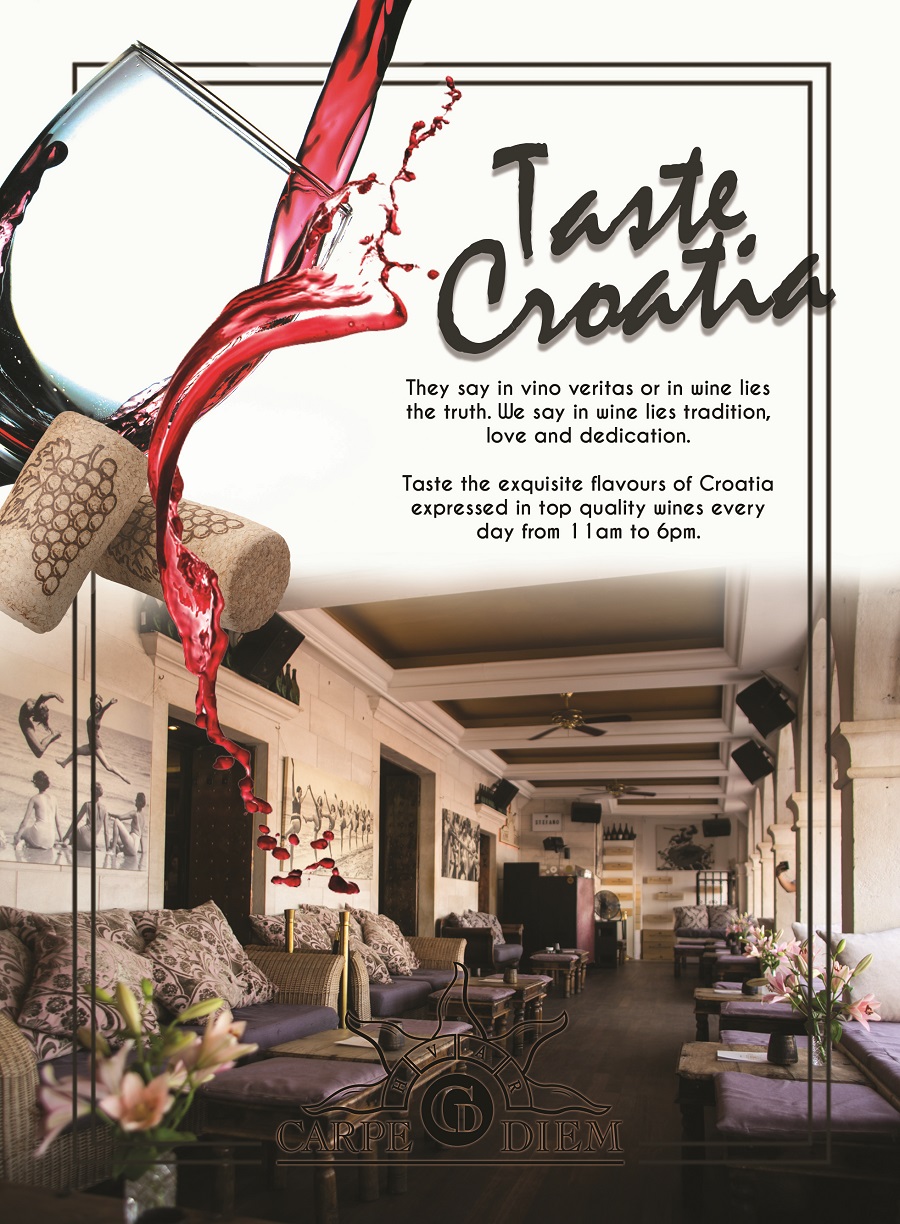
A new concept from Carpe Diem during the day, promoting the quality wines of the island (and, I think, also the rest of Croatia) - Taste Croatia.
Less on the daytime party, more on the gourmet quality, and a chance to learn more about the fine wines of the island and beyond. The wines will also be available for purchase - an ideal Hvar souvenir.
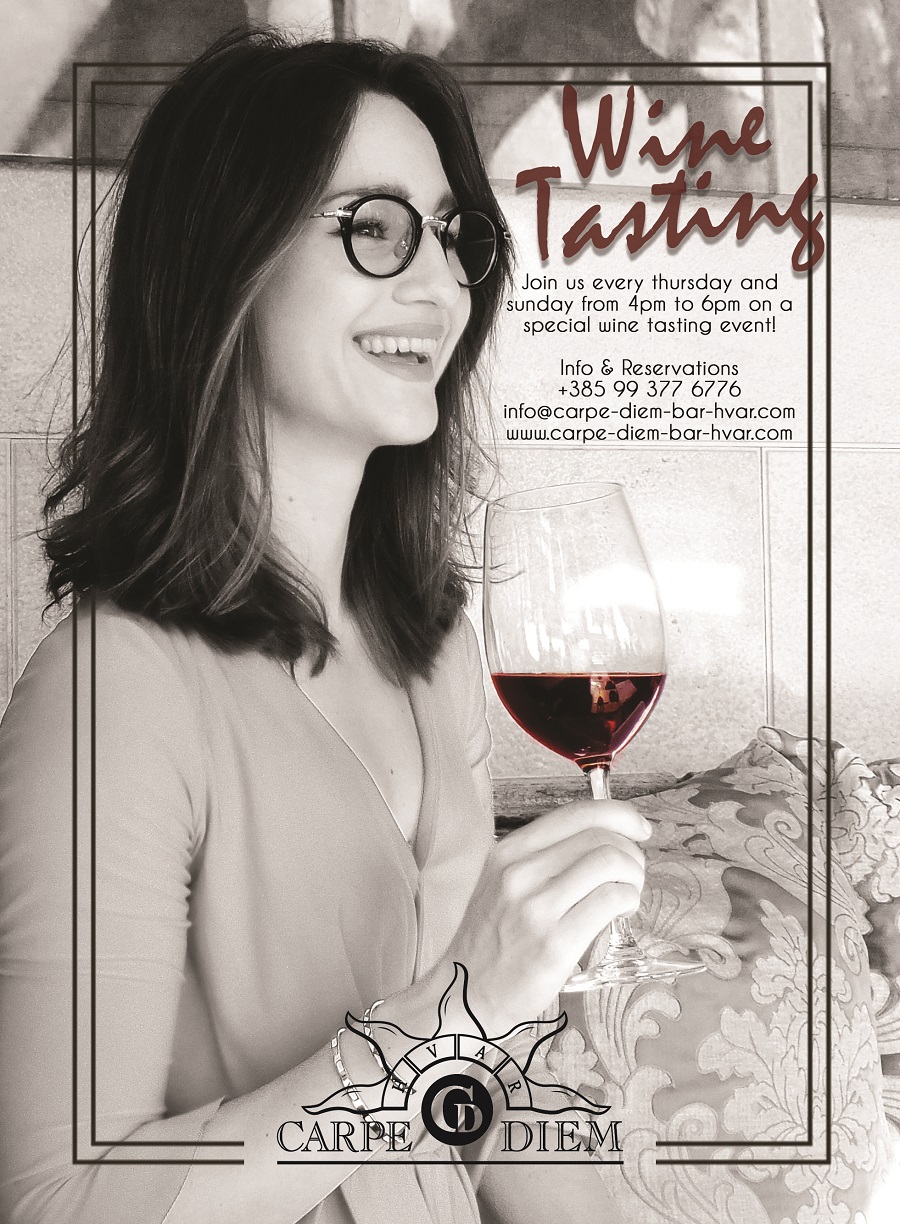
Come on Thursdays and Sundays from 16:00 to 18:00 teach week for a special wine tasting event. Details for reservations in the flyer above.
So there we are, one more step in the right direction, and an excellent platform for Hvar's excellent winemakers to impress visitors to Hvar Town.
Perhaps now is the time to say thanks for the memories, Ultra Europe, but we need to keep working on our brand?
To learn more about the potential of Hvar as a food and wine destination, Creating Quality Gourmet Tourism in Croatia: Case Study Hvar.
The Split Wine Shopper’s Guide: 10 Under 100
29 July, 2019 - TCN is delighted to welcome Kit Pepper to the team. An American wine writer living in Split, Kit's first piece is a very useful journey into Croatian wine - 10 great bottles for under 100 kuna.
We all have the same trouble buying wine: it’s the risk of getting something you don’t like. And that risk is sky-high when you’re standing in a foreign supermarket staring at a wall of bottles labeled with grapes you’ve never heard of. But with a native guide (native to wine, that is) you can avoid expensive mistakes and start to build a personal wine list of favorites.
Here are 10 Croatian bottles from various Tommy, Konzum, Spar, Studenac and Victa stores around Split that are great quality and value for less than 100 kuna. The key to buying supermarket wine is to keep an eye on freshness. For white wines in this price range, avoid buying if the vintage year on the bottle is more than two years ago, and for reds, more than three. By summer of any year, you should be able to find whites and rosés from the previous year. If it all seems older than it should be, try a different store. (The store may have an overstock and the wine will sit there until it sells.) Also, avoid stores whose wine shelves are in the window—you don’t want baked wine!
The prices below are what I paid; they may be slightly different where you shop.

WHITE WINE
- Adžić Graševina, Kutjevo, 75kn This is the kind of white wine the critics call “pretty,” because it’s fairly delicate, with a floral and pear aroma. If you could see smells, this might look like lace. It’s not sweet at all, but has a nice perfume and is great for sipping. The Graševina grape is a real star in Kutjevo, in Croatia’s eastern wing.
- Krauthaker Sauvignon Classic, Kutjevo, 65kn Vlado Krauthaker is one of the most prominent winemakers in Kutjevo—all of his wines are solid, but I particularly like his Sauvignon Blanc because it’s not trying to be from somewhere else. This isn’t your tropical-flavored Sauvignon. Instead you’ll get a combination of fresh-cut grass, lemongrass and lemony herbs. Try it with smoked salmon crostini with herbed cream cheese and cucumber.
- Lipanović Vugava, Vis, 70kn Vis island is pretty isolated out there, so it’s not surprising that the Vugava grape hasn’t gone traveling much, although you can find it growing here and there on other islands in Dalmatia. But for a true taste of Vis, you can’t do better. It makes a rich, ripe wine with yellow apple and herb aromas that goes well with shrimp and shellfish, or Asian ingredients like coconut, ginger, creamy curries. Pad Thai, anyone?
- P.Z. Pošip Pošip, Korčula, 85kn During Croatia’s communist period, wine grapes had to be brought to one of many co-operative wineries at harvest. A respectable number of these remain, and some are very well regarded for making superior wine. Pošip is Korčula’s renowned white grape, and the co-operative P.Z. Pošip, in Čara, makes a great version, with ripe apricot flavors and a satisfying weight in your mouth. A super sipper.
- Zlatan Otok white blend, Hvar, 42kn Smell this wine and it’s likely to remind you of driving across Hvar in summer: dusty, sun-roasted roadside brush, wild thyme, a little rosemary. There are also whiffs of golden apple and quince here, and maybe some melon. It’s a full-bodied blend of local grapes including Bogdanuša and Prč. All that in a 42-kuna bottle—impressive!

ROSÉ WINE
- Skaramuča Rosé, Pelješac, 50kn A lot of rosés from Plavac Mali end up in the Opol style—more like a light red, without the refreshing nothingness of a true pink. This one is a real rosé, and it somehow manages to taste like the landscape: touches of sea brine, wild herbs and scrub brush plus a light cherry-cranberry fruitiness. With zero sweetness, this wine goes with virtually any summer food you could think of!
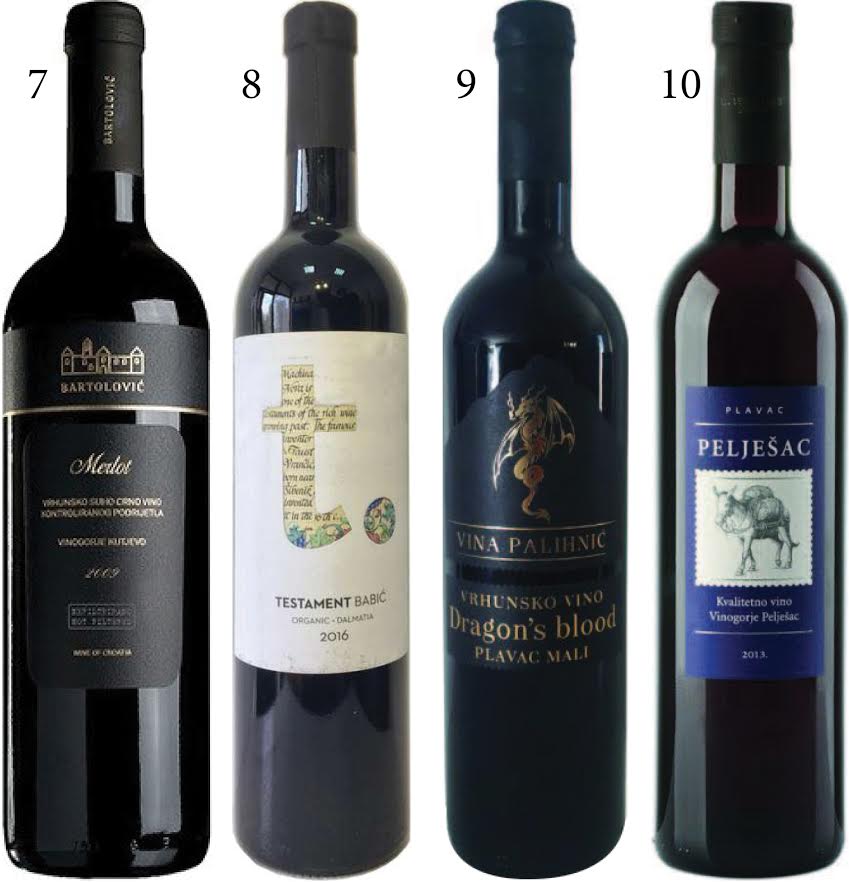
RED WINE
- Bartolović Merlot, Kutjevo, 80kn This Merlot is one of a few exceptions to the “don’t buy cheap, old wine” rule. I tasted the 2012 and it was great, with generous aromas of black cherry, oak wood and a touch of vanilla. This one has a refreshingly bitter finish (think radicchio or unsweetened chocolate) and hearty tannins, so it’s best with meats.
- Testament Babić, Northern Dalmatia/Šibenik, 90kn One of the best things about Croatian wine is all the local grapes that grow nowhere else in the world. Few sommeliers in New York or Paris have tasted Vugava or Babić, but here you can casually sip any of Croatia’s hyper-local, exclusive varieties. Babić is at home near Šibenik, where Testament grows organic grapes for a wine that tastes like a salad of blackberries, cherries, and blueberries with a touch of lily perfume. Fruity and easy to drink.
- Vina Palihnić Dragon’s Blood Plavac Mali, Pelješac, 50kn A goofy name, but a very well made wine from one of the regions you want your Plavac to come from. If you’re looking for a crowd-pleaser red just for sipping, this is it: it’s juicy but not heavy, easy on the tannins, with rich blackberry and red delicious apple flavors. It’s also great with lamb and a tomato-cucumber-feta salad.
- Vinarija Dingač Peljesac, Pelješac, 40kn If the wine right above this one is best described as fruity (and it is), this Plavac Mali is on the earthy end of the spectrum. And if the word “crowd-pleaser” leaves you cold, this wine might seem more dignified. Here, earthiness tastes like red cherries rather than sweet black ones, like autumn leaves, a touch of black tea, and pine or resinous wild herbs. This is less for sipping, more of a food wine—have it with lamb, roast pork, stuffed cabbage.

Katherine “Kit” Pepper is an American wine writer living in Split. She first came to Croatia on wine business in 2007 and was a strong proponent of Croatian wine at her New York City wine shop, Kit’s Underground Wine & Spirits. Her writing appears in U.S. wine publications and she is a specialist editor of books on wine and spirits after an earlier career in book publishing. She holds the WSET Diploma and is a Certified Wine Educator.
You can connect with Kit by email on This email address is being protected from spambots. You need JavaScript enabled to view it.
Meet the Only Master of Wine Tasting Experience in Croatia: Jo Ahearne MW
July 9, 2019 - The Croatian wine scene welcomed its first resident Master of Wine in 2014, as Jo Ahearne MW moved from London to Hvar. Since then her wines from Hvar grape varieties have been a hit nationally and internationally. Here is how you can taste them.
It’s been just under five years since Australian-trained winemaker and Master of Wine Jo Ahearne first came to Hvar to start her eponymous winery Ahearne Vino. And what a five years it’s been - her Plavac Mali, ‘South Side’, was voted number five in Decanter magazine’s top Balkan red wines; her rosé, Rosina (named after her mother), was voted both in the top five influential Croatian wines by Saša Špiranec and expert’s tip in Decanter magazine; her amber wine, Wild Skins, awarded 90 points by Decanter magazine and voted in the top ten Croatian wines by Kult Plave Kamenice while the same publication awarded her Pošip 93 points.

Now ensconced in the old co-operative building in the beautiful hilltop village of Vrisnik with four wines under the Ahearne Vino banner, Jo has gone from strength to strength. Exporting Croatian wine to seven countries (with two more coming up soon), she has now prepared the winery to receive visitors this summer. So I thought it was time for the man who was responsible for introducing her to the island of Hvar to see what all the fuss was and go and enjoy one of her in-depth ‘geek tastings’.
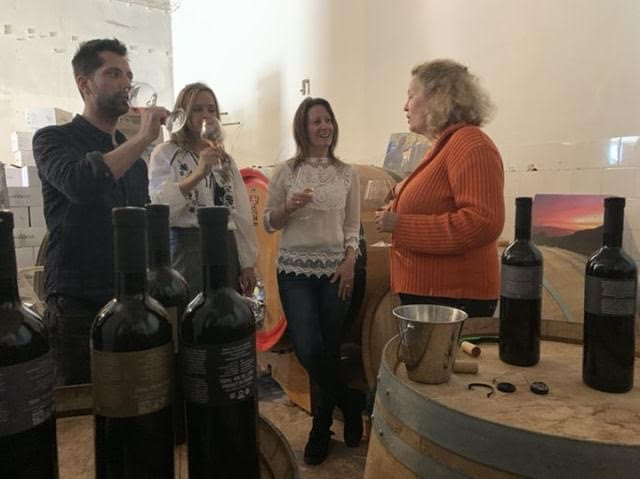
I’d spoken to Sarah Jane Begonja from Chasing the Donkey blog about the Villa tasting Jo had done in Zadar a few months back and laughed when she’d told me one of the guests hadn’t invited his girlfriend because he ‘didn’t realise how much fun it’d be’. I guess many people would assume a tasting held by an MW (there are more astronauts than Masters of Wine) would be all wordy and worthy with at least one test paper at the end!
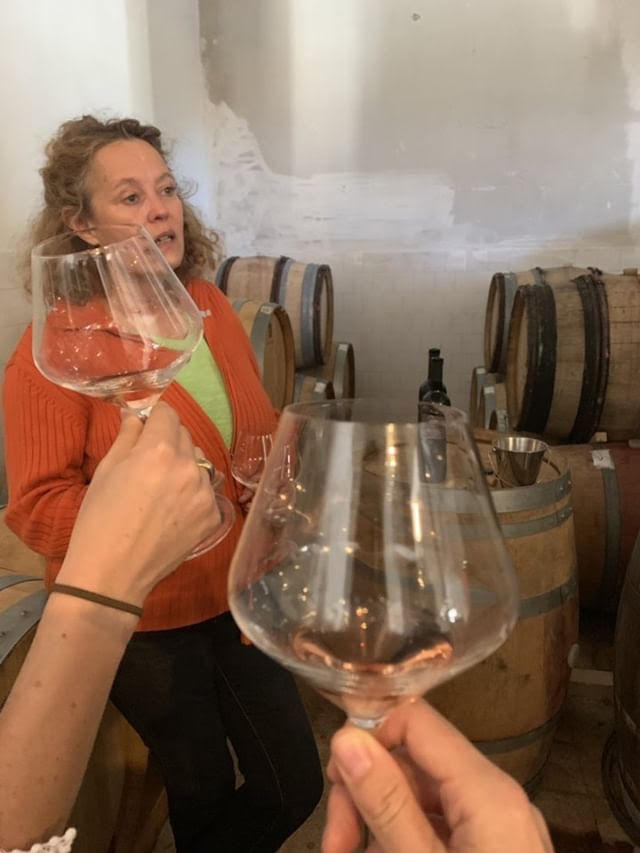
I can certainly concur - Jo has a great capacity to educate people about food and wine by using simple language that normal people can relate to and understand. And if you want to talk football and West Ham United, you have come to the right winery.
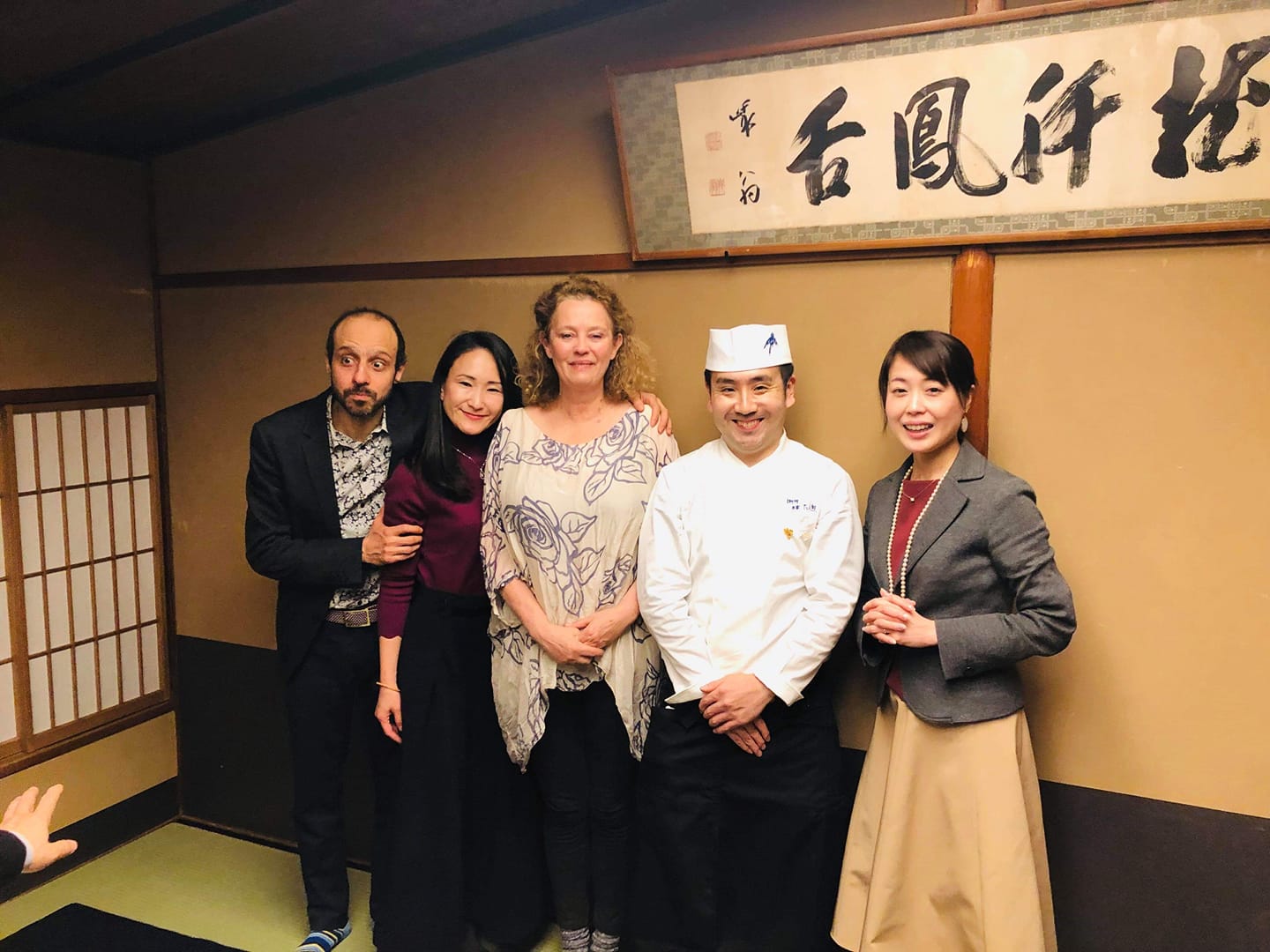
(Jo in Kyoto on her recent tour of Japan and Australia - she exports her Hvar wines to both countries)
But not to fear, the tasting is full of humour with stories from Jo’s time in Croatia and from her work around the world. We tasted wine from her barrels and tanks while she explained where the grapes came from and how everything is made. She made it seem a lot more straightforward than it probably is! We then moved outside to grab a chair, look at the amazing view of the Hvar mountains and taste through her bottled wines.
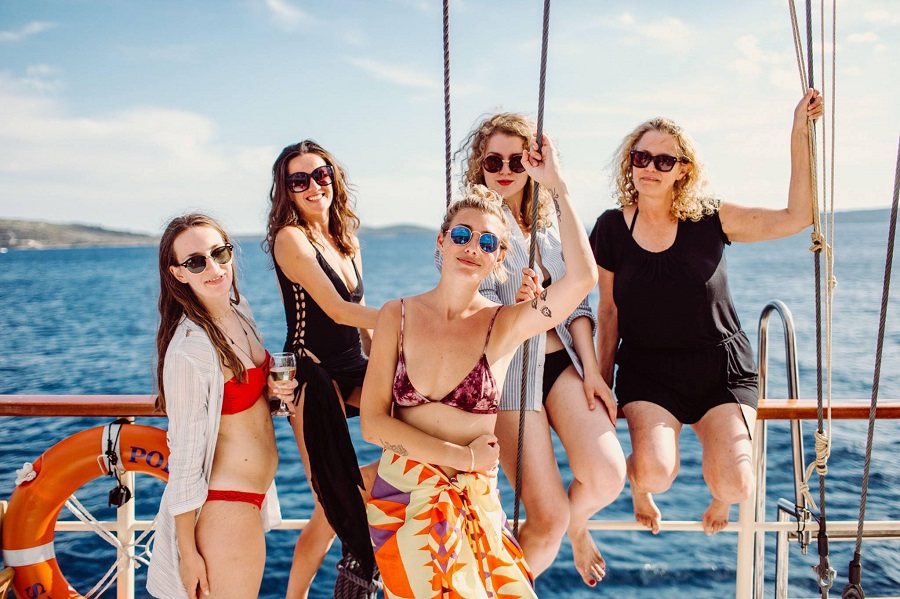
(Jo relaxing with Split expats last summer after conducting a tasting on board)
Of course, Jo does less in-depth tastings of just her bottled wines and, in recognition that some people just don’t want to leave the pool, she brings the tasting to your villa or yacht. But for those who want to really get to grips with the island and its wines she has a four-wheel drive vineyard tour, tasting and lunch - after that you might even be inspired to start the Master of Wine journey yourself......
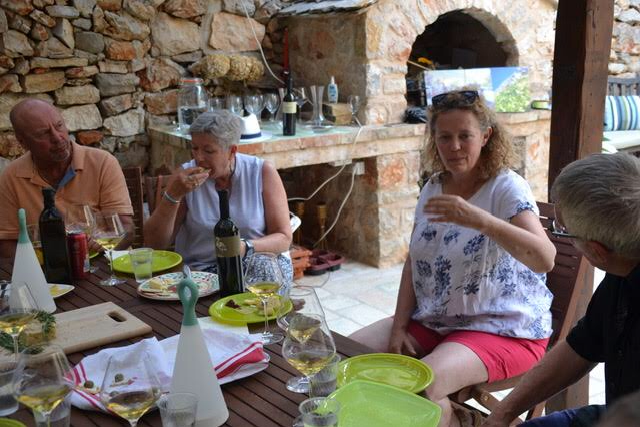
(Jo conducting one of her private villa tastings on Hvar)
And so to the tasting in her winery in Vrisnik, which has a lovely rustic feel, as well as divine mountain views. Vrisnik is an inland village about 3km from Jelsa and 7km from Stari Grad. An authentic and quiet Dalmatian village where you can taste great wines made from Hvar grape varieties crafted by hands from London. All fab. In order to be a bit more useful to the reader, I asked Jo to tell us a little about her wines:
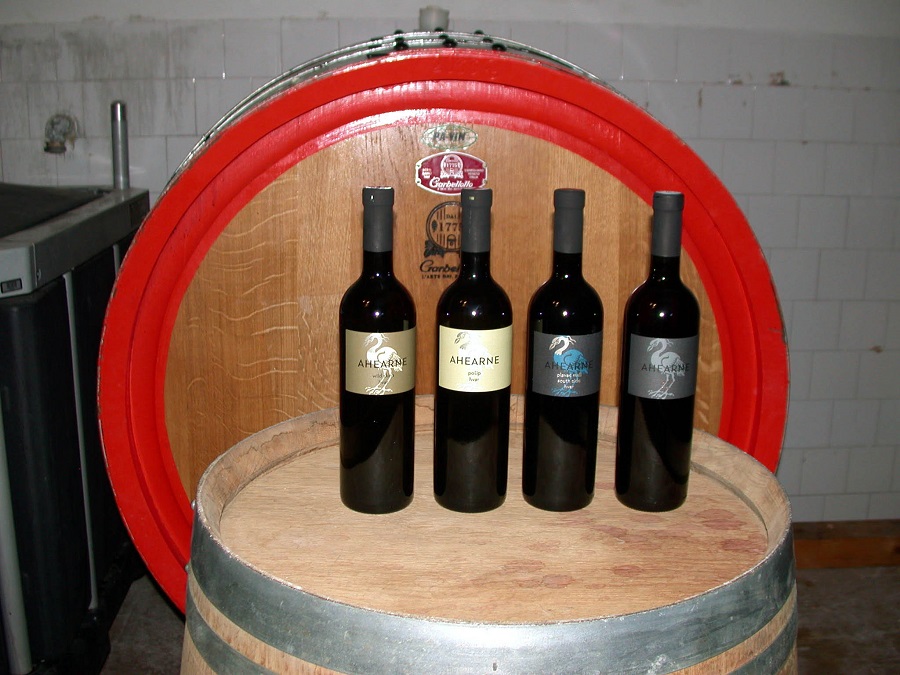
(Photo credit Mirko Crncevic)
Rosina - made from Darnekuša, a nearly extinct variety which brings elegance, freshness and complexity to rosé. Raspberry and cherry flavours with a great structure and texture from 8 months lees contact.
Wild Skins - fermenting local varieties on skins brings more flavour and structure than would normally exist. Quince and pear with a hint of toast and honey. Fresh but textured and complex.
South Side Plavac Mali - using only fruit from the best sites on the steep, southern hills, this wine is more elegant and perfumed than many Plavac Mali. Relying on gentle, hand extraction and ageing in refined, low key French oak barrels for 18 Months the South Side has supple tannins with raspberry, plum flavours and a hint of chocolate and the aromas of hillside herbs.
Pošip - lemon and white peach with an underlying toasty note from an element of barrel fermentation in old French barrique. Smooth texture from 9 month sur lie and a gentle kick of spice from a little skin contact.

A really fun, educational and completely unsnobbish wine tasting experience from the only Master of Wine in Croatia.
You can contact Jo on This email address is being protected from spambots. You need JavaScript enabled to view it. or 00385 917664515 or follow Ahearne Vino on Facebook.
Celebrate a Legend: Zlatan Aurum Gold Leaf Posip at Suncani Hvar Hotels
June 21, 2019 - It is more than three years since one of Croatia's greatest winemakers passed away - a rare chance to try a special bottle in his honour - Zlatan Aurum.
He was a titan.
I remember the shock of hearing of the sudden and untimely passing of celebrated winemaker Zlatan Plenkovic in March, 2016, as he suddenly collapsed and died on the Split to Stari Grad ferry.

From his base in Sveta Nedjelja, with its fabled steep Plavac Mali vineyards, the Zlatan Otok Grand Cru was one of Croatia's most highly prized bottles. But his range of wines included so much more than his flagship red, and I remember reporting on his Posip winning Decanter gold in London.
Soon after his untimely death, the Zlatan Otok winery announced that it wanted to honour the life of Zlatan with a special, very limited edition called Zlatan Aurum (Zlatan's first name means 'gold' in Croatian, hence the Latin name for gold in the special wine, which had 23 carat-gold leaf inside). This is how the Zlatan Otok winery announced the wine at the time:
We wanted to do something in honor of Zlatan so we came to idea of white wine with gold leafs. Zlatan achieved many successes with this wine so we decided to do it with pošip. Gold represents him and the vinery as his legacy also, not just beacause his name, and the name of winery in Croatian language means gold, also because Zlatan was such great person, loved by many people.
.-limited edition wine
-vintage 2015
-23 karat edible gold leafs
-13% alcohol
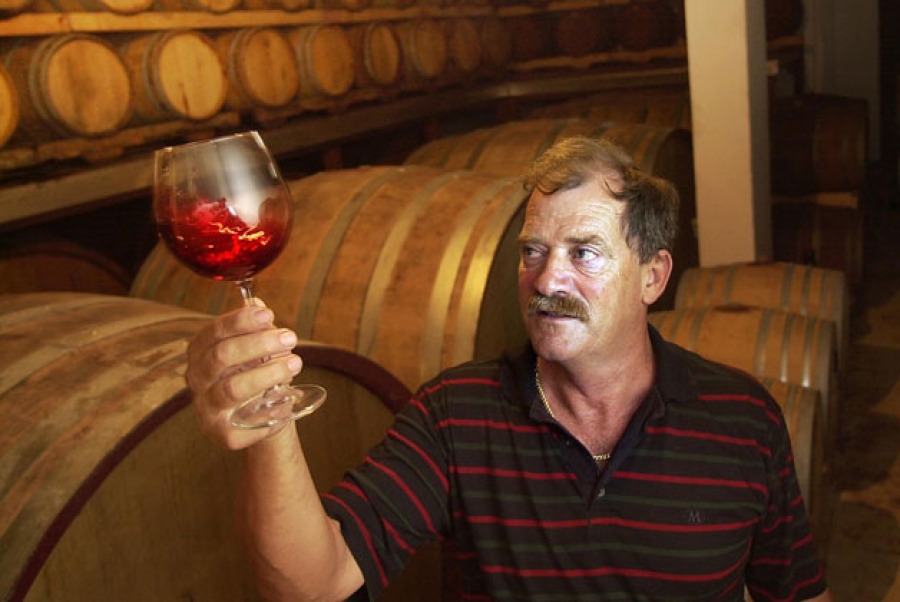
I have heard nothing about Zlatan Aurum since that first announcement.
Until this morning. During a conversation after breakfast with the director of Hotel Adriana, I learned that Zlatan Aurum was one of a number of very impressive wines on the Val Marina Restaurant wine list. And not only that, but Suncani Hvar Hotels are the only place outside Zlatan's Sveta Nedjelja where you can find this rare wine.

You can read TCN's tribute to Zlatan Plenkovic here.
Looking to learn more about Croatian wine? Check out the Total Croatia Croatian Wine in a Page guide.
Divina Vina: Meet the Only Croatian Winemaker in Split
June 18, 2019 - There were a number of fascinating characters at Festa Days on the Kornati island of Zut this weekend - next up, the only winemaker in Split. Meet Divina Vina.
There are some events in Croatia that have so much positive energy and fabulously interesting people that they become an essential addition to the TCN calendar.
Festa Days on Zut is one such occasion.
The culinary masterpiece started last year as a way for Restaurant Festa to celebrate its incredible 25-year story and success. Opened in the middle of the Homeland War on an uninhabited island with no water, electricity or ferry, one could easily question the sanity of the brave and determined owners. 25 years later, last September, no less than five international Master Chefs, accompanied by five of Croatia's top chefs, put on quite a show at the inaugural Festa Days, which you can read about here.
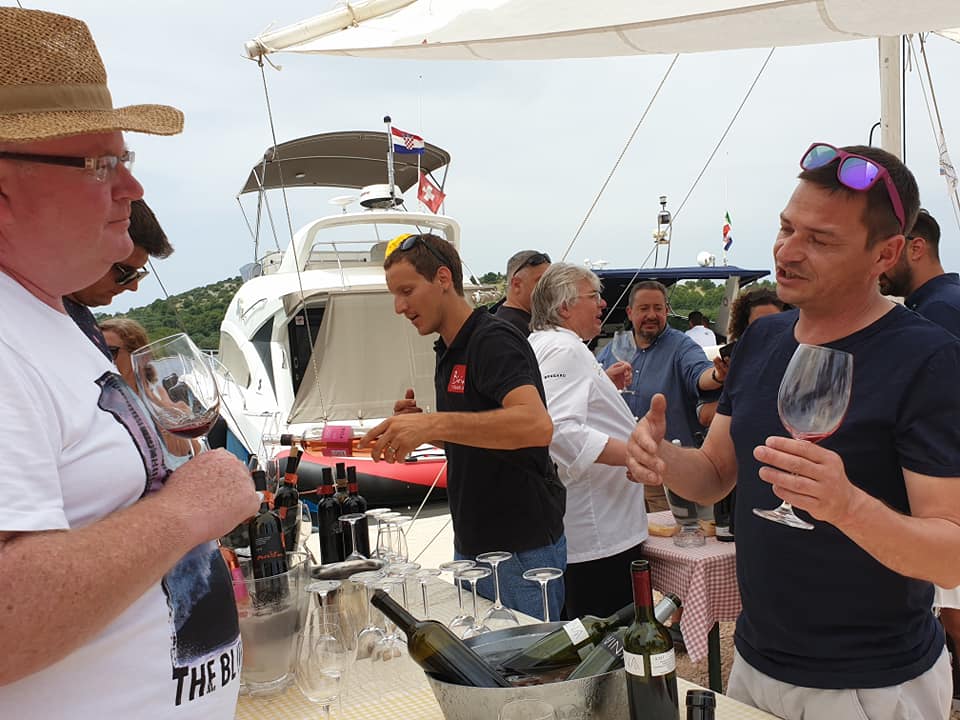
More on this year's event coming shortly, but I am still trying to process the number of incredible stories heard and characters met in the 24 hours I spent on Zut this year. We have already done the story of the Zut entrepreneur who decided to open a shop on the island, despite the fact that there are no permanent residents on the island. His business is booming and a wonderful story of how thinking outside the box in modern-day Croatia can bring great results.
But did you know about the only winemaker in Split? An atomic winemaker called Ivan Dragicevic who produces 12,000 bottles a year of truly excellent wines in the basement of a 12-story Split apartment block. Yes, you read that right.

(The vineyards of DIngac)
My first contact with the man behind Divina Vina was on about course number 5 of the excellent Festa 10-course special. Ivan was pouring a rather excellent Posip from Korcula into our glasses, from the village of Cara, home of Posip. I asked him how the Posips of Cara compared to nearby Smokvica, and we started to have a nice chat about the wines of the island of Marco Polo. I assumed that he was one of the Korculan winemakers I had not yet come across until I was having a drink with another fascinating character on Zut, who was a lot more informed than me.
"Have you met the only winemaker in Split yet?"
And so we wandered over to check out the excellent food and wine tastings during the second afternoon of Festa Days, where last night's Korculan Posip winemaker turned into the only winemaker in Split. It is a lovely story.
Although he was born in Split, Ivan's roots are from the village of Vrgorac in inland Dalmatia - not downtown Vrgorac but up in the hills. Vrgorac is famous for four things as far as I have been able to ascertain so far in my time in Croatia: it has the best strawberries in the country; it is the birthplace of celebrated poet Tin Ujevic, it has the only festival in the world that celebrates 'bikla' - an unusual beverage which combines red wine and goat milk - the Vrgorac biklijada remains on my bucket list; and it was the location for an incredible slacklining stunt as a promo ad for Volvo Trucks - see the video below.

But in the coming years, Vrgorac could become known for another thing - the origins of the only winemaker in Split.
Meet Ivan with roots from Upper Vrgorac. Throughout his formative years, he helped out in the family vineyards, which started a passion for wine. Despite pursuing an education and career as a mechanical engineer, he tried where he could to learn more about the art of making wine through online videos and similar methods.
He was a very good student.
And after some time, he decided to pursue his dreams. What if he could purchase high-quality grapes from excellent locations in his beloved Dalmatia and then turn them into quality wine in the basement of his apartment block? A crazy idea to many perhaps, but that is exactly what he has done. A fully working 200m2 winery in residential Split with 5 REALLY exciting wines.
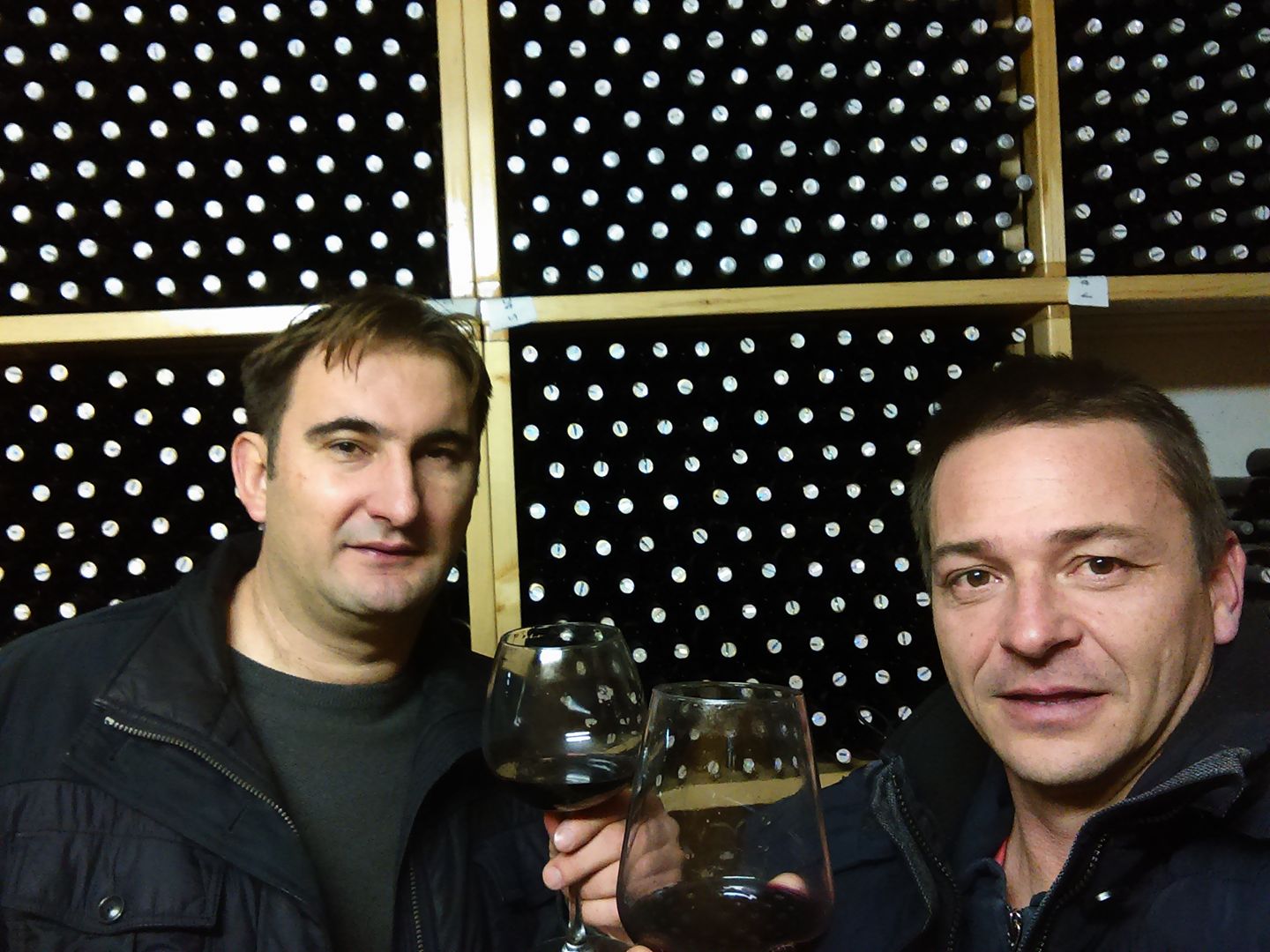
The concept is simple. Buy the very best grapes from the very best Dalmatian locations, then use your knowledge to turn them into excellent wines.
I loved the wines I tasted, plus the simplicity of the approach. There are two wines from Korcula, a classic Posip and an orange variation; a powerful Dingac and fruity Plavac rose from Peljesac, and a meaty Babic from near Primosten. Total production is about 12,000 bottles.
Ambitions for expansion are limited - perhaps to increase production to 25,000 bottles, with the addition of one more Dalmatian grape variety. Divina Vina does not offer tastings to the public, but they do exist by personal invitation. The only place I have come across where you can taste them so far is at Paradox Wine and Cheese Bar in Split. I heartily recommend you give the wines a try.
You can follow Divina Vina on Facebook.
WOW and Rogaška Glassworks Celebrate Crystals and Wines
A wine and crystal summit of sorts between Slovenia and Croatia took place on Wednesday, 22 May, at the Rogaška Glassworks store in Zagreb. The event was organized by the Women on Wine (WOW) association, with some twenty members and a large number of media representatives attending.
Since the clouds threatened with rain, the event did not take place as expected in front of the shop, with a view of the Croatian Fine Arts Home building. Instead, guests mingled surrounded by beautiful crystal and art objects exhibited in the shop. Perhaps it was for the best since that made it possible for everyone to be close enough to observe these precious objects, handmade from the most beautiful glass and crystal. After all, love between Zagreb and Rogaška has always been a two-way street, and the store’s doors have recently been re-opened for all the fans of premium crystal objects.
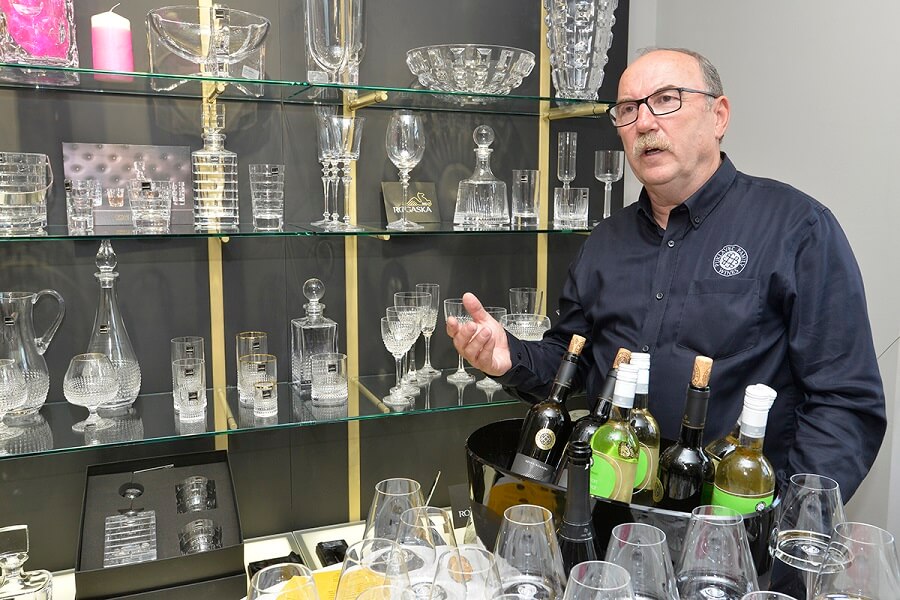
The Rogaška Glassworks is the perfect combination of tradition, art and passion that lasts more than 350 years. The tradition includes the skills of the old masters, while the openness towards the new technologies has inspired a contemporary design that nowadays captivates customers of all generations. The factory has produced, engraved, painted, carved and decorated crystal objects since the 17th century. It delivers impressive 20 tons of crystal products a day and about eight million products annually. As many as 95 percent of output is exported abroad, and Rogaška was the first company from the former Yugoslavia which had its showroom on New York’s Madison Avenue.
The WOW members and media representatives had an opportunity to see for themselves the quality and beauty of artistically crafted glasses sculpted by Croatian artist Gordana Drinković. Rogaška was represented at the event by Sašo Ilić and Špela Sedminek. “In addition to being proud of the tradition, excellent export results and numbers, we are happy that our workshops produce well-known awards for most festivals in the region – from Porin, Dora, Večernjak’s Roses to Tour de Croatia, Snow Queen, ATP tournament and many other prominent events. In Rogaška, we never stop searching for new forms, precise craftsmanship, exciting new solutions – in forms, patterns, colours. Everything is handmade, and our crystal is one of the cleanest and therefore the brightest. It is important to note that everything is created, designed and realized in Slovenia.”
Although the product range of Rogaška is innovative and vibrant, and includes pots, ashtrays, candlesticks, picture frames, flower vases, and many other things that make a home or are excellent as a gift – the WOW members and the media were this time mostly interested in high-quality crystal glasses and decanters, quite appropriately for members of a wine association and lifestyle media representatives. The wine programme offers top-of-the-range luxury crystal glasses that provide wine connoisseurs with a new dimension of wine enjoyment, and a bar section with impeccable design to enjoy more relaxed moments.
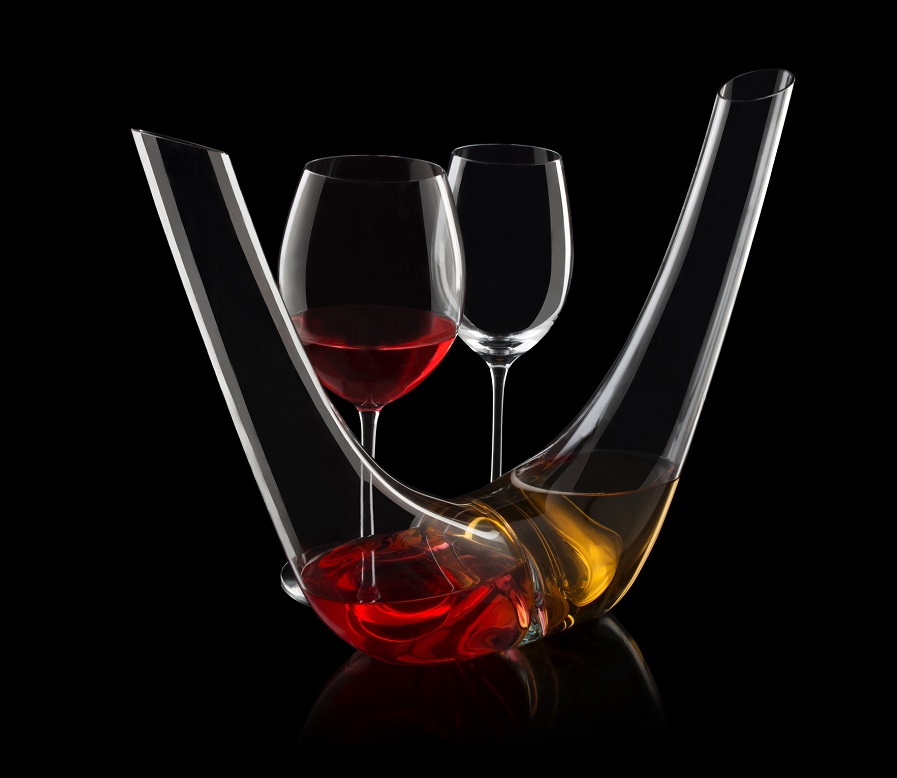
The beautiful glasses of the Armonia line were filled on Wednesday with equally exceptional wines produced by Puklavec Family Wines Jeruzalem Ormož. The glasses are of a unique shape and are ideal for both sparkling wines and regular wines. The line also includes excellent simple glasses for water or whiskey and even wine on certain occasions.
This time, the guests drank “Penina Brut Estate”, sparkling wine produced by the Charmat method from Chardonnay and Pinot Gris. It is lively, refreshing sparkling wine with only seven grams of sugar residue, with plenty of citrus notes, and a dash of hazelnut and red fruits. The second wine was “Cuvee of Sauvignon and Pinot Gris”, an incredibly fresh and light wine suitable for this time of the year. Sauvignon gives it freshness and Pinot Gris elegance, with a harmonious and balanced result. It pairs excellently with chicken and poultry, and especially with all the asparagus dishes. Next was fantastic, complex Pinot Gris, “Pinot Grigio 7 Numbers”, 2017, an exceptional varietal wine featuring intense aromas of ripe apples and peaches, with a hint of vanilla – spicy, slightly pungent, with a long aftertaste. Finally – two Muscat wines. “Muškat Ottonel” is a dessert wine that nicely combines sweetness and lightness, distinguished by low alcohol content, making it excellent for tasting even when it is sweltering. It is a sweet mid-body wine that is characterized by nutmeg aromas and freshness and goes well with desserts. Finally, bubbles again. “Muškatna Penina” is a refreshing wine with sugar residue and enchanting nutmeg aromas.
As politicians would say, the Slovenia-Croatia summit, which gathered female wine experts, top Slovenian wine producers and – last, but not the least – the hosts, the wonderful Rogaška Glassworks – was hugely successful. We look forward to furthering bilateral co-operation in the areas of wine and enjoyment of life.
More wine news can be found in the Lifestyle section.
Photos by Rene Karaman

